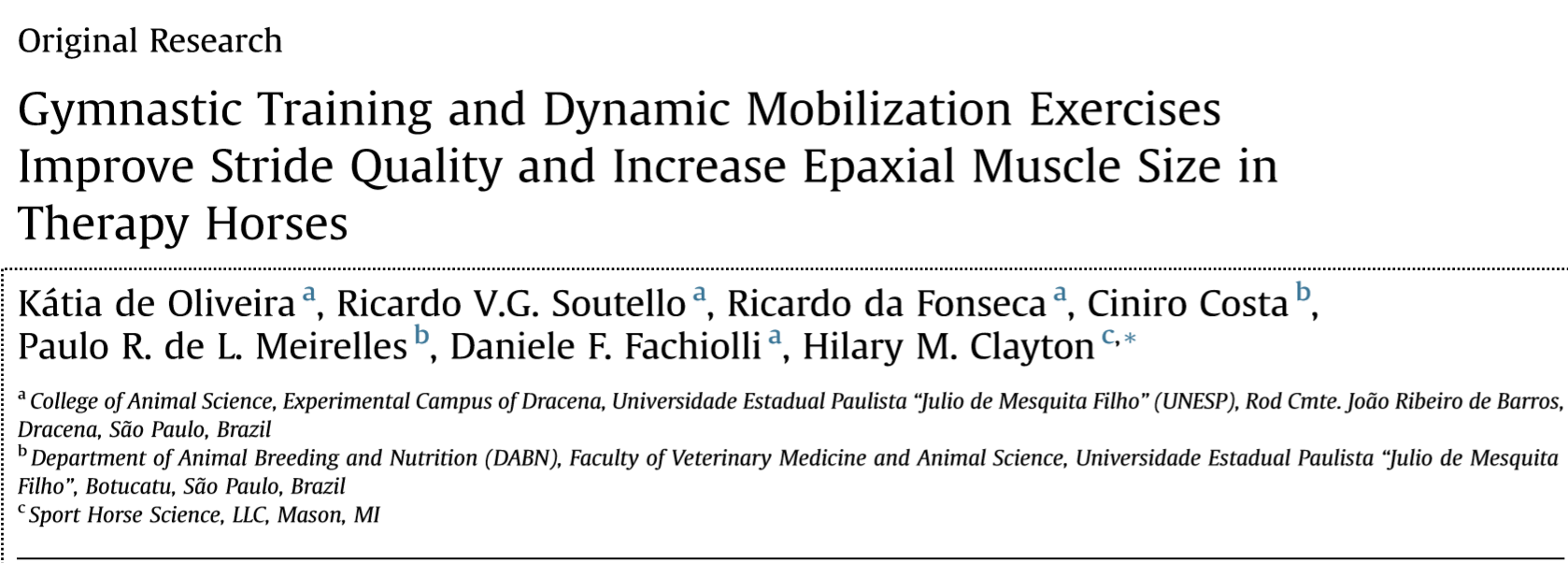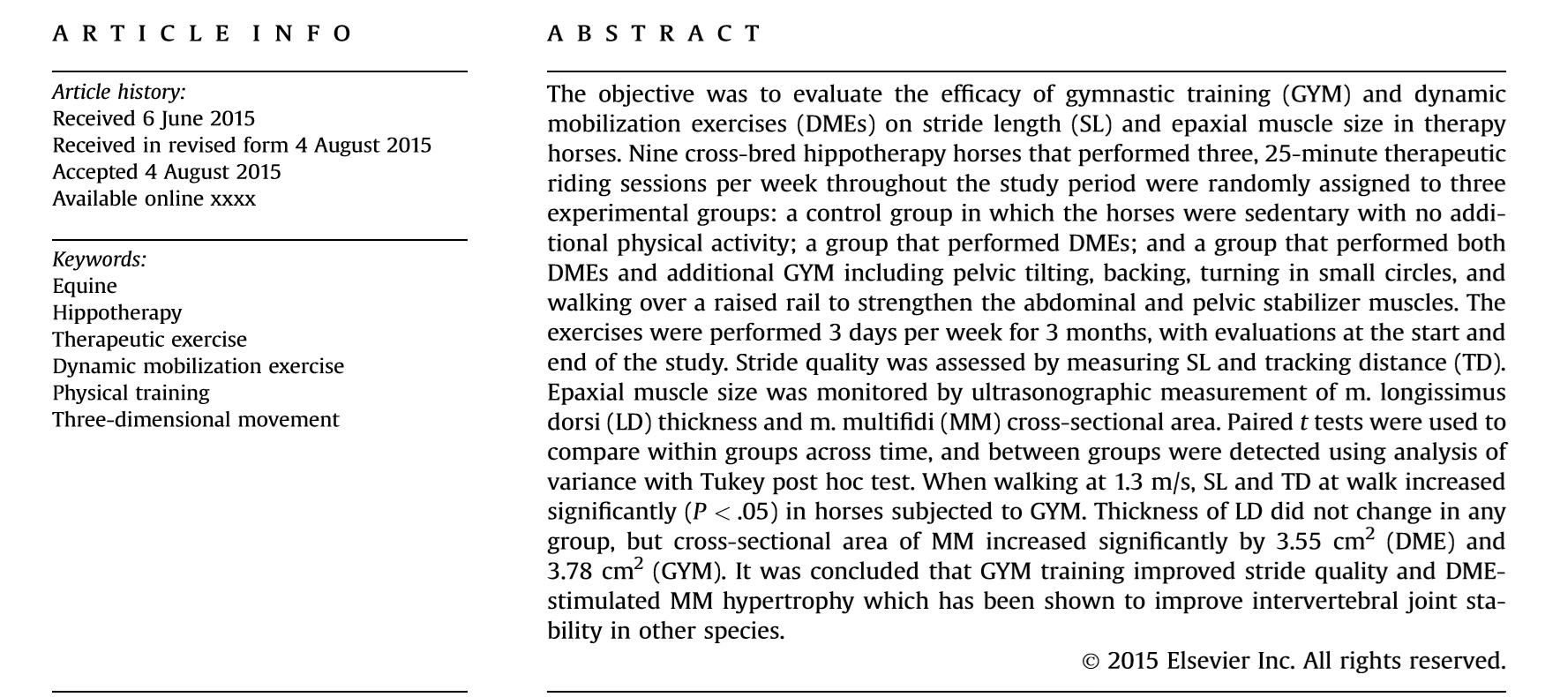Gymnastic Training and Dynamic Mobilization Exercises...in Therapy Horses
 August 2015: Journal of Equine Veterinary Science 35(11-12)
August 2015: Journal of Equine Veterinary Science 35(11-12)
DOI10.1016/j.jevs.2015.08.006
While working with Therapy horses, we implemented exercises to help improve physical fitness levels and enhance therapy results. We were so thrilled and grateful to discover this study which backs the reasoning behind our efforts. Equine therapy work is challenging, and therapy horses are some of the neediest bodywork candidates.
"The inclusion of these exercises in the therapy horse’s program is likely to improve both their ability to provide a high-quality therapeutic experience to patients and may have a beneficial effect on their longevity as participants in a therapeutic riding program."
Furthermore:
"Another technique not used in the present study but that might be useful for increasing hindlimb protraction in therapy horses is massage. Hill and Crook [17] reported that massaging the superficial gluteal muscle, m. biceps femoris, and m. semitendinosus significantly increased both passive and active hind limb pro-traction with horses taking longer trotting stride after massage. "
Partial rendering of research is below.
Full study may be accessed here: FULL STUDY

Abstract: The objective was to evaluate the efficacy of gymnastic training (GYM) and dynamic mobilization exercises (DMEs) on stride length (SL) and epaxial muscle size in therapy horses. Nine cross-bred hippotherapy horses that performed three, 25-minute therapeutic riding sessions per week throughout the study period were randomly assigned to three experimental groups: a control group in which the horses were sedentary with no additional physical activity; a group that performed DMEs; and a group that performed both DMEs and additional GYM including pelvic tilting, backing, turning in small circles, and walking over a raised rail to strengthen the abdominal and pelvic stabilizer muscles. The exercises were performed 3days per week for 3months, with evaluations at the start and end of the study. Stride quality was assessed by measuring SL and tracking distance (TD). Epaxial muscle size was monitored by ultrasonographic measurement of m. longissimus dorsi (LD) thickness and m. multifidi (MM) cross-sectional area. Paired t tests were used to compare within groups across time, and between groups were detected using analysis of variance with Tukey post hoc test. When walking at 1.3m/s, SL and TD at walk increased significantly (P < .05) in horses subjected to GYM. Thickness of LD did not change in any group, but cross-sectional area of MM increased significantly by 3.55cm2 (DME) and 3.78cm2 (GYM). It was concluded that GYM training improved stride quality and DME-stimulated MM hypertrophy which has been shown to improve intervertebral joint stability in other species.
Introduction:
Hippotherapy uses horses as instruments for practitioners to treat individuals who have disabilities or special needs. These riders are often poorly balanced, poorly coordinated, and overweight[1], all of which increase the stress on the therapy horses. It is not surprising, therefore, that therapy horses are susceptible to work-related injuries which may involve muscular pain[1,2]. It is speculated that these equine injuries may be similar to the muscular pain experienced by human laborers, who, due to overloading or repetitive movements combined with a lack of alternative types of exercise, become susceptible to obesity, back pain,and articular mobility problems[3].
Lumbar pain interferes with the horse’s stride quality[4] which has been shown to deteriorate when the riders present special characteristics such as pelvic misalignment and excessive body weight[1]. We hypothesize that poor stride quality could be improved if the horses performed additional exercises specifically designed to recruit and strengthen the core stabilizing and locomotor musculature while moving the joints through awide range of motion.
One of the benefits of therapeutic riding is that the three-dimensional (3D) movements of the rider’s pelvis show similar trajectories and displacement amplitudeswhen riding a horse at walk to those of an able-bodied person walking overground[5], which stimulates patients to activate their core musculature and stabilize their trunk in the same way as they would if they were walking.
The horse’s stride quality contributes to the value of the therapeutic experience so it is important for therapy horses to move freely and without restriction of their range of motion[6]. Thus, the therapy horse should have a full range of 3D movement in order for the patient to receive a quality treatment that accelerates the therapeutic and rehabilitative process.
According to Dvorakova et al[7], the combined action of the horse’s ventral (hypaxial) and dorsal (epaxial) musculature influences their 3D movement patterns, so specific exercises should be performed by therapy horses with the objective of strengthening the abdominal, sub-lumbar, and epaxial muscles. The pelvic stabilizer muscles,which maintain correct alignment of the sacroiliac, hip and stifle joints, are necessary for transmission of locomotor forces generated by the hind limb to the horse’s trunk[8]. It is well known in people that gymnastic training (GYM) involving muscular stretching and/or strengthening exercises contributes to the prevention of occupational diseases and enhances rehabilitation from injuries[9].
Muscular stretching performed before athletic activity reduces the risk of muscular strain although muscular strength and power may be impaired[10]. Strength training not only improves muscular force and power, it also protects against injury by activating and strengthening the deep stabilizing musculature[9].
In horses, most conditioning studies have focused on cardiovascular fitness in specific sports and relatively little scientific information is available describing the effects of stretching or strength training exercises. Dynamic mobilization exercises (DMEs) involve voluntary movements of the horse’s cervical and thoracolumbar intervertebral joints through a wide range of motion with the primary objectives of activating and strengthening the muscles that move and stabilize the intervertebral joints[8]. The kinematic effects of these exercises have been described[11,12], and their value for increasing the cross-sectional area of the equine spinal deep stabilizing m. multifidi (MM) has been reported[13,14]. These exercises may also recruit and strengthen the abdominal and pelvic stability muscles although the latter effects have not been evaluated. Exercises that are thought to play a role in strengthening the abdominal and sublumbar muscles include caudaltilting of the pelvis, stepping backward, and turning in small circles around a barrel[15]. It has been suggested that the pelvic-stabilizing muscles, which include the gluteal muscles, m. biceps femoris, and other hamstring muscles,can be strengthened by stepping over obstacles at walk[15,16].
CONCLUSION
Our findings show that performing GYM three times per week increased the horse’s SL and TD which are considered to be indicators of improved stride quality and may enhance the value of the therapeutic experience for patients. Performance of DMEs three times per week stimulated hypertrophy of MM which has been shown to contribute to stabilization of the intervertebral joints in anticipation of voluntary movement.
The inclusion of these exercises in the therapy horse’s program is likely to improve both their ability to provide a high-quality therapeutic experience to patients and may have a beneficial effect on their longevity as participants in a therapeutic riding program.
FULL STUDY AVAILABLE: Gymnastic Training and Dynamic Mobilization Exercises Improve Stride Quality and Increase Epaxial Muscle Size in Therapy Horses. Available from:
 August 2015: Journal of Equine Veterinary Science 35(11-12)
August 2015: Journal of Equine Veterinary Science 35(11-12)
